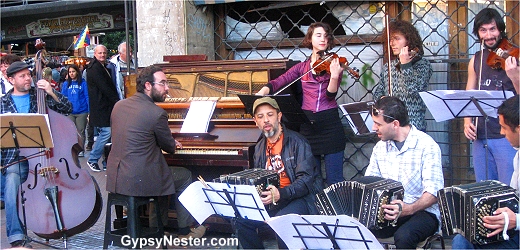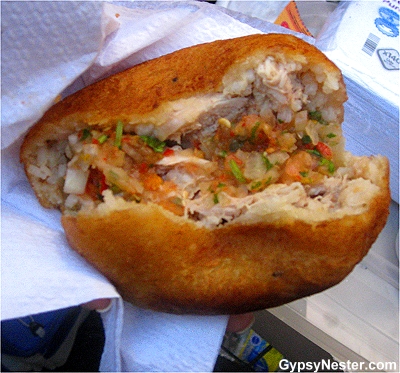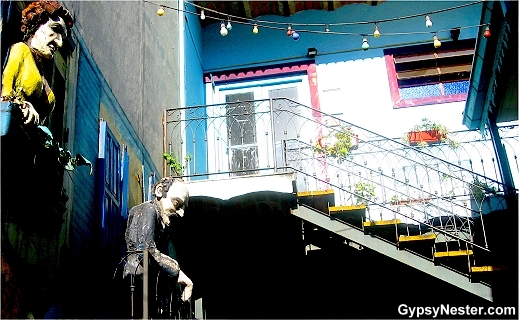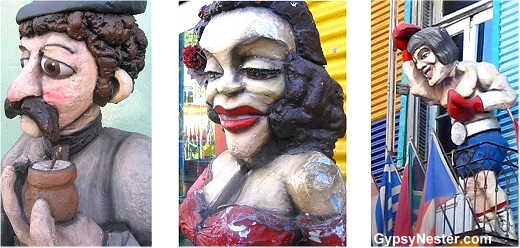
Buenos Aires, like most large urban areas, is actually a collection of varied communities, and as we explored many of them we found each offered unique backgrounds and qualities.
The cowboy culture of Mataderos, the residential feel of Once, the urban chic of Richoleta, and the bustling politics and monuments of San Nicolas all add up to a great world capital.

Perhaps no two barrios of the city capture quintessential Buenos Aires better than San Telmo and La Boca.
In fact San Pedro Gonzalez Telmo, named for the patron saint of seafarers, is considered the oldest neighborhood in the city.
It is where the first settlement was established by the Spanish explorer Pedro de Mendoza nearly five hundred years ago.

Our modern day exploration found many interesting colonial buildings lining quaint stone streets in what has become the artistic center of town.
We made our way to Plaza Dorrego, in the heart of San Telmo, because it was Sunday, and on Sunday the place to be is the Feria de San Telmo.

More open-air flea market than fair, this collective sale of antiques, art, clothing, jewelry, food and just about anything else under the sun, has been happening every weekend since 1970.

But it is more than a market, solo guitarists, African drum groups, and a nine piece mini-orchestra of strings, accordions, and even a full sized piano performed along the streets surrounding the plaza.


Wading into the square, we were drawn to a gathering by a crowd and more music, our curiosity led us to a street tango in progress.
A small dance troupe had laid out a wooden dance floor over the ancient cobblestones and was putting on quite a show.
 From there we found a woman selling what looked to be empanadas, but she insisted they were something different. A dish unique to Uruguay that had no name.
From there we found a woman selling what looked to be empanadas, but she insisted they were something different. A dish unique to Uruguay that had no name.
Nameless or not, we just called it delicious.
 Nameless packets of tasty goodness in hand, we continued through the maze of tables, stands, and booths until the sun sank behind the buildings and the vendors began to pack up.
Nameless packets of tasty goodness in hand, we continued through the maze of tables, stands, and booths until the sun sank behind the buildings and the vendors began to pack up.
That was our signal to find our way back to the subte, the local name for the subway.
La Boca
 The next day we ventured a little farther out from the center of Buenos Aires, to the old port area known as La Boca.
The next day we ventured a little farther out from the center of Buenos Aires, to the old port area known as La Boca.
There is some uncertainty as to the origin of the name, the obvious explanation would be that the area lies at the mouth, or la boca in Spanish, of the small river Riachuelo.
But the early residents of La Boca came from Genoa, Italy, more specifically the part of Genoa known as Boccadasse or Bocadaze, so their descendants claim that the name stems from that association.
In fact the connection to the Italian city is so strong that in 1882 La Boca actually seceded from Argentina and briefly flew the Genoese flag.
 We noticed the Italian influence as we walked from the bus to the famous Caminito, or little road.
We noticed the Italian influence as we walked from the bus to the famous Caminito, or little road.
At the top of the tiny street we were immediately accosted by tango dancers who had an overwhelming desire to have their picture taken with us… for a fee of course.
But hey, it gave us an opportunity to whip out our tango faces one more time, so we figured it was worth it.

 Moving up the way into the restaurants, tango halls and crap shops that line the Caminito, we were hit by barkers at almost every establishment.
Moving up the way into the restaurants, tango halls and crap shops that line the Caminito, we were hit by barkers at almost every establishment.
It seemed like not a single storefront let us pass without a pitch.


This was by far the most touristy section of Buenos Aires that we had seen, to the point that it made it hard to appreciate the very cool old construction underneath all of the hucksterism.
We did our best to ignore the onslaught and see past it, but finally we decided to try to find the real neighborhood behind the facade and wandered a few blocks away from the hustle and bustle.





That is where we found the authentic versions of the colorful corrugated metal houses that were the inspiration for the bright, odd-caricature-statue adorned replicas that line the Caminito.
We also found a little corner cafe where a pizza didn’t cost thirty dollars.
It was not the best pie ever, not by a long shot, but as usual we found the unvarnished real life experience to be far superior to the sanitized version put forth for the tourist trade.
 So we hung out, talked with our vibrant, outgoing waitress, watched the show that the neighborhood dogs put on, and generally just took it all in.
So we hung out, talked with our vibrant, outgoing waitress, watched the show that the neighborhood dogs put on, and generally just took it all in.
When the afternoon sun turned soft we set out through the tourist traps once again, content that we had experienced something close to what La Boca once was.
Just before turning the corner from the Caminito to catch our bus, we looked back and gave one more tango face, just for good measure.
David & Veronica, GypsyNester.com



Never seen a betetr post!
Your coverage of Buenos Aires makes me want to go. I am disappointed this neighborhood turned out to be so touristy though. The tango dancer who posed with David looks like she’s in pain! LOL
La Boca is very touristy, but most of the city is not at all. Very worth a visit.
I love the idea of street tango. Looks like fun!
I stayed in Sal Telmo for a few weeks last year and fell in love with the place. There is so much to explore and so many cool little cafes and restaurants. It’s definitely one of the most interesting barrios of BA.
Beautiful stuff…Hope to make it to Buenos Aires next year!
Thanks, hope you do and have a great time.
La Boca looks awesome! I love exploring different parts of cities
Don’t you just love the colors? A photographer’s dream!